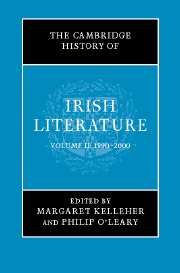Book contents
- Frontmatter
- Introduction
- 1 Literature and politics
- 2 The Irish Renaissance, 1890–1940: poetry in English
- 3 The Irish Renaissance, 1890–1940: prose in English
- 4 The Irish Renaissance, 1890–1940: drama in English
- 5 The Irish Renaissance, 1880–1940: literature in Irish
- 6 Contemporary prose and drama in Irish 1940–2000
- 7 Contemporary poetry in Irish: 1940–2000
- 8 Contemporary poetry in English: 1940–2000
- 9 Contemporary prose in English: 1940–2000
- 10 Contemporary drama in English: 1940–2000
- 11 Cinema and Irish literature
- 12 Literary historiography, 1890–2000
- Afterword: Irish-language literature in the new millennium
- Afterword: Irish literature in English in the new millennium
- Guide to major subject areas
- Index
- References
6 - Contemporary prose and drama in Irish 1940–2000
Published online by Cambridge University Press: 28 March 2008
- Frontmatter
- Introduction
- 1 Literature and politics
- 2 The Irish Renaissance, 1890–1940: poetry in English
- 3 The Irish Renaissance, 1890–1940: prose in English
- 4 The Irish Renaissance, 1890–1940: drama in English
- 5 The Irish Renaissance, 1880–1940: literature in Irish
- 6 Contemporary prose and drama in Irish 1940–2000
- 7 Contemporary poetry in Irish: 1940–2000
- 8 Contemporary poetry in English: 1940–2000
- 9 Contemporary prose in English: 1940–2000
- 10 Contemporary drama in English: 1940–2000
- 11 Cinema and Irish literature
- 12 Literary historiography, 1890–2000
- Afterword: Irish-language literature in the new millennium
- Afterword: Irish literature in English in the new millennium
- Guide to major subject areas
- Index
- References
Summary
Introduction
The years 1940–2000 have been a period of uneven growth and development for Irish-language prose and drama. The most significant development of all during these decades was the emergence of a great diversity of literary forms as many writers gradually distanced themselves from the more restricting aspects of Revivalist ideology and began to experiment more with language, structure and subject matter. Critical perspectives also evolved and it was recognised that the cultural context in which the Irish language had survived now demanded expression in a manner which often defied the strictures imposed by genre or particular aesthetic paradigms. Linguistic norms are challenged in many works, both by Gaeltacht and non-Gaeltacht writers, and questions of cultural change and cultural hybridity become stylistic concerns as much as themes in much of the prose literature of the period. During this time Máirtín Ó Cadhain was to gain prominence as a major prose writer, and a host of other new and distinct voices emerged such as those of novelists and short story writers Diarmaid Ó Súilleabháin, Alan Titley, Micheál Ó Conghaile and Pádraig Ó Siadhail. These years also witnessed a continuation of a strong Gaeltacht tradition of autobiography and auto-ethnography, side by side with an unprecedented amount of experimental prose writing. The publishing house Sáirséal agus Dill, which was established in 1946, was responsible for the publication of much of the most original and innovative fiction of the period, while in the 1980s the newly established Coiscéim and Cló Iar-Chonnachta were to play a prominent role in the encouragement of many new and younger writers.
- Type
- Chapter
- Information
- The Cambridge History of Irish Literature , pp. 270 - 316Publisher: Cambridge University PressPrint publication year: 2006
References
- 1
- Cited by

